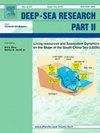Deep-sea life associated with sediments and polymetallic nodules from the Central Indian Ocean Basin: Insights from 18S metabarcoding
IF 3
3区 地球科学
Q2 OCEANOGRAPHY
Deep-sea Research Part Ii-topical Studies in Oceanography
Pub Date : 2025-05-16
DOI:10.1016/j.dsr2.2025.105487
引用次数: 0
Abstract
The eukaryotic diversity of ocean sediments and polymetallic nodules (PMN) from the Central Indian Ocean Basin (CIOB) is scarcely characterized and molecular studies are lacking, comprising a key research gap. This study aimed to leverage 18S rRNA gene amplicon metabarcoding of environmental DNA (eDNA) to describe the eukaryotic diversity of ocean sediments and PMN from the CIOB. Sediment and PMN samples were obtained at a depth of 5000 m from three CIOB ocean floor sites: Impact Reference Zone (IRZ), Preservation Reference Zone (PRZ), from the PMN International Seabed Authority Contract area of the Government of India, and a location outside the proposed mining zone named BC20. DNA was isolated and the 18S rRNA V9 region was amplified using primers 1391f and EukBr targeting approximately 150bp. Taxonomy was assigned using the reference databases: MZGDB database (MetaZoo WorldAtlas Database) for Animalia and SILVA138 release for Fungi and Protista. Alpha and beta diversities were calculated using the reads assigned to known phyla. In total, 11078041 paired-end reads were generated and 1327 ASVs were assigned to the kingdom level, while 297 were assigned to a minimum of phylum level for Animalia (213 ASVs), Fungi (66 ASVs), and Protista (18 ASVs). The taxa observed included Annelida, Arthropoda, Bryozoa, Chordata, Cnidaria and Mollusca; these are the phyla observed encompassing the 29 Animalia taxa. In total, 3 phyla from Fungi, Ascomycota, Basidiomycota, and Mucuromycota, and 8 other phyla, Amoebozoa, Apicomplexa, Ciliophora, Dinoflagellata, Euglenozoa, Heterolobosea, Orchrophyta and Retaria were noted. Sediment and nodule communities from the same sampling sites were clustered in ordination plots. This study is a pioneering effort to document deep-sea biodiversity in the Central Indian Ocean Basin (CIOB) using the eDNA metabarcoding method. With the hard substrates in the CIOB hosting a rich variety of flora and fauna, future mining activities could threaten these ecosystems. By providing a vital baseline for biodiversity assessments, the study highlights the necessity of extensive sampling to facilitate ongoing monitoring and mitigate potential impacts from exploration and mining.

与中印度洋盆地沉积物和多金属结核相关的深海生物:来自18S元条形码的见解
中印度洋盆地(CIOB)海洋沉积物和多金属结核(PMN)的真核生物多样性几乎没有表征,缺乏分子研究,构成了一个关键的研究空白。本研究旨在利用环境DNA (eDNA)的18S rRNA基因扩增子元条形码来描述海洋沉积物和来自CIOB的PMN的真核多样性。沉积物和PMN样本来自CIOB的三个海底地点:影响参考区(IRZ),保护参考区(PRZ),来自印度政府的PMN国际海底管理局合同区域,以及拟议采矿区外名为BC20的地点。分离DNA,用引物1391f和EukBr扩增18S rRNA V9区,扩增目标约150bp。采用参考数据库进行分类:动物类采用MZGDB数据库(MetaZoo world datlas database),真菌和原生生物采用SILVA138数据库。α和β多样性是用已知门的reads来计算的。总共产生了11078041对末端读取,1327个asv被分配到界水平,297个asv被分配到最小门水平,分别为动物类(213个)、真菌类(66个)和原生动物(18个)。观察到的类群有环节动物、节肢动物、苔藓动物、脊索动物、刺胞动物和软体动物;这些是在29个动物分类群中观察到的门。共发现真菌门、子囊菌门、担子菌门、粘液菌门3门,变形虫门、顶复虫门、纤毛虫门、鞭毛虫门、裸藻门、异藻门、褐藻门、滞藻门8门。同一样点的沉积物群落和结瘤群落呈有序样地聚集。本研究是利用eDNA元条形码方法记录中印度洋盆地(CIOB)深海生物多样性的开创性工作。由于CIOB的硬基质承载着丰富多样的动植物,未来的采矿活动可能会威胁到这些生态系统。通过提供生物多样性评估的重要基线,该研究强调了广泛采样的必要性,以促进持续监测和减轻勘探和采矿的潜在影响。
本文章由计算机程序翻译,如有差异,请以英文原文为准。
求助全文
约1分钟内获得全文
求助全文
来源期刊
CiteScore
6.40
自引率
16.70%
发文量
115
审稿时长
3 months
期刊介绍:
Deep-Sea Research Part II: Topical Studies in Oceanography publishes topical issues from the many international and interdisciplinary projects which are undertaken in oceanography. Besides these special issues from projects, the journal publishes collections of papers presented at conferences. The special issues regularly have electronic annexes of non-text material (numerical data, images, images, video, etc.) which are published with the special issues in ScienceDirect. Deep-Sea Research Part II was split off as a separate journal devoted to topical issues in 1993. Its companion journal Deep-Sea Research Part I: Oceanographic Research Papers, publishes the regular research papers in this area.

 求助内容:
求助内容: 应助结果提醒方式:
应助结果提醒方式:


